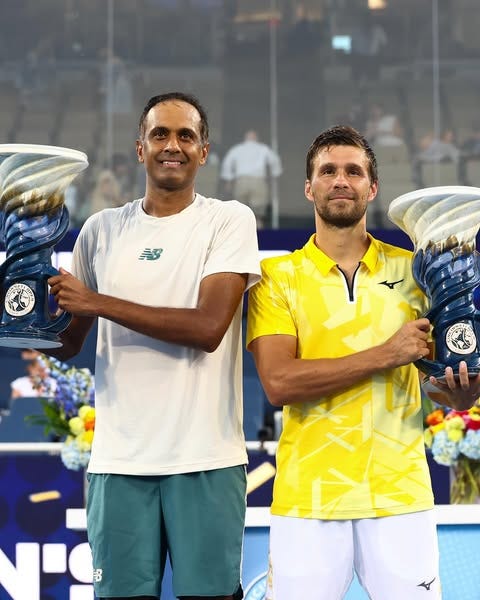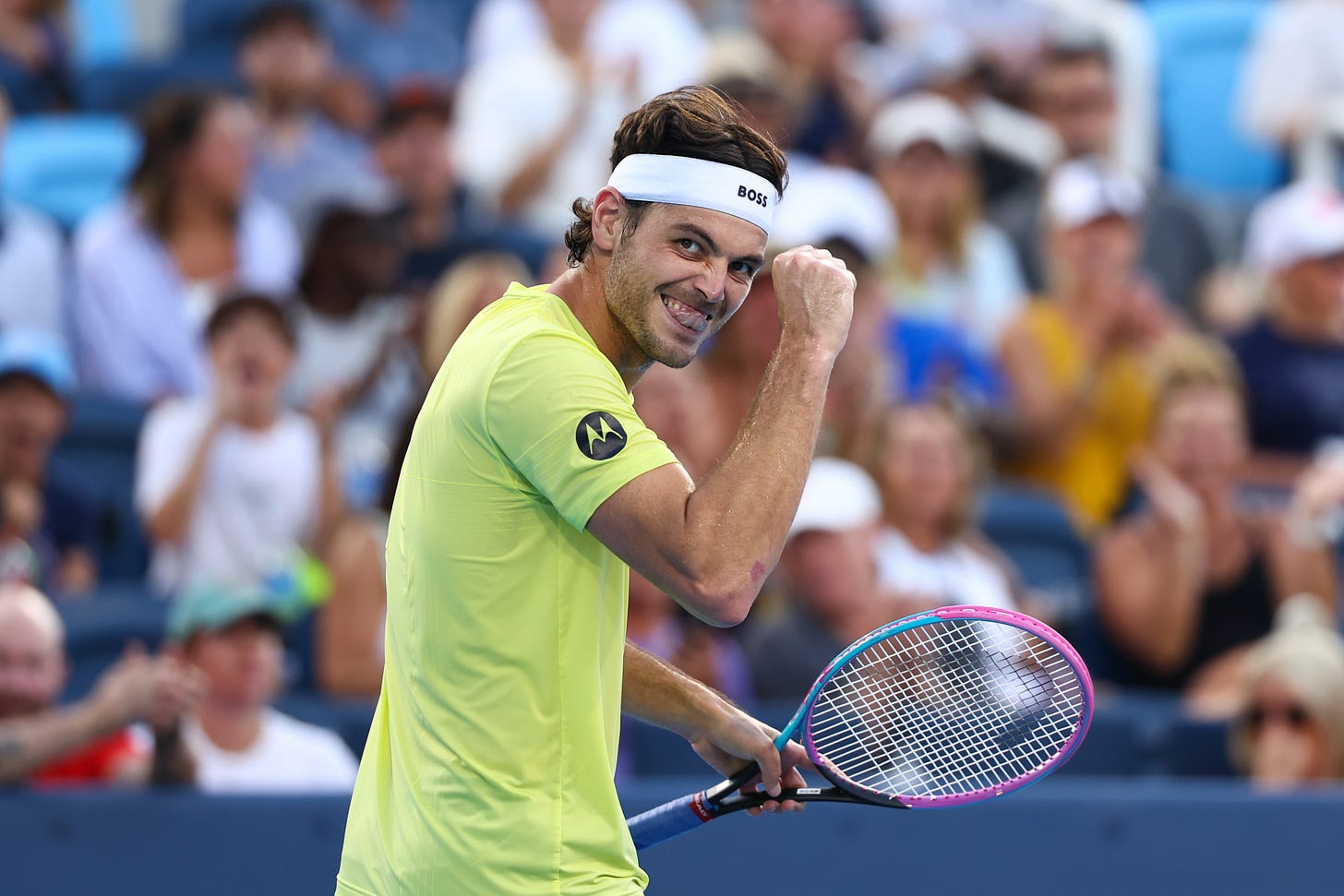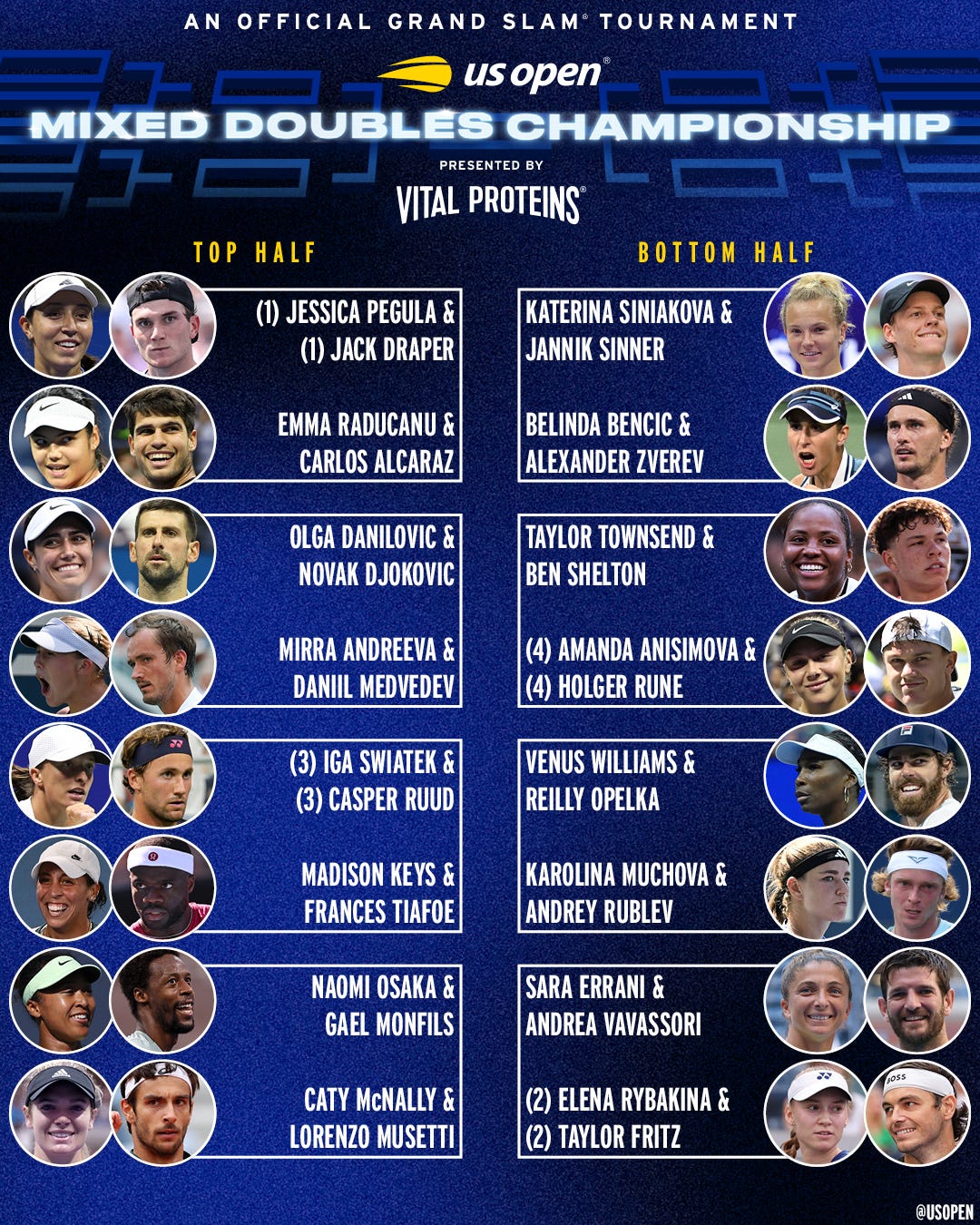Andrea Vavassori's Mixed Emotions
Simmering tensions between doubles specialists and singles stars will be settled on court in the U.S. Open's mixed doubles revamp.
As I was writing this curtain-raiser article about the start of the highly-anticipated U.S. Open mixed doubles event Tuesday, a screenshotted tweet started ricocheting around various groupchats of mine.
Jannik Sinner’s participation figures to be in doubt after he retired from Monday’s Cincinnati men’s singles final due to illness, and so tennis journalist Jon Wertheim nominated a possible replacement: his fellow Indianan Rajeev Ram, a congenial 41-year-old doubles specialist who just won the doubles title in Cincinnati over the weekend.
But hours later, a retired former top-10 singles player chimed in to make it clear he was deeply unimpressed by Wertheim’s suggestion.
“How bout another actual tennis player,” Mardy Fish replied.
Fish’s belittling comment was more openly acidic than you’ll usually hear from a player, past or present—and might be somewhat rooted in lingering bad feelings about a years-old Davis Cup snub which may have expedited the end of Fish’s tenure as captain months later.
But the sniping sentiment illustrates a surprisingly embittered tension, prevalent particularly on the men’s tour, between the now-nearly-entirely separate populations of singles and doubles players.
Many successful singles players feel, increasingly, like the doubles specialists are freeloaders on their coattails, taking up half the space at tournaments and 20 percent of the prize purses while contributing little commercial value. Successful doubles specialists have their own senses of pride in their abilities as well, proud to have found a way to make a living in the sport they’ve played their entire lives, even if singles stardom is nearly always the Plan A or primary dream for every young player.
Many of the top singles players, in private conversation—or public comments by Reilly Opelka—will contend that if push comes to shove, singles players’ superior athleticism and ballstriking would win out over a doubles specialist’s tactics or guile. Doubles specialists, obviously, back themselves as well, and can point to moments of beating top singles players during their past cameos in doubles.
The newfangled U.S. Open mixed doubles event, and its field of almost entirely singles stars, will put this debate on a bigger stage than it’s ever been on before.
In Cincinnati, Taylor Fritz backed his side of the aisle.
“I would love to have a lot of the top [doubles specialist] teams in the draw,”
Fritz began. “And if they were to beat the top singles teams, you know, then I think that they've proven their point. And because I've seen a lot people calling it like a exhibition or doesn't count: I personally think this is the strongest mixed doubles field you're going to see at a Grand Slam, in my opinion. And if the [doubles specialist] teams that are in come in and win the event, then I'll eat my words and say I’m wrong. But I personally think the level is going to be really high. You have the best players playing with each other; not doubles-specific players. To be honest, a lot of times [when] you have singles players playing doubles, they perform really well, so that's just my take on it.”
Not withstanding any last minute withdrawals or substitutions, as of now, only one pair of the 16 teams in the U.S. Open mixed doubles field is made up of two doubles specialists: defending champions Sara Errani and Andrea Vavassori, who also won this year’s French Open mixed doubles together.
The Bryan Brothers, whom I interviewed last month ahead of their Hall of Fame induction later this week (more from them soon), understandably said they would lean toward the doubles talents.
“If I had to bet my life, I would always bet on the more polished doubles team instead of putting two singles players together for the first time,” Mike Bryan said of Errani and Vavassori. “They've already won a few slams [together]. They know how to poach, they know where to be. So it's using like tactics and and they're great ball strikers too.”
“I might change that prediction if you gave Alcaraz and Raducanu a training camp where they could get some matches under their belt,” Bob Bryan chimed in. “But I think if you throw them out there against a team that's played together and won Grand Slams, I would probably have to favor the experienced doubles players. You know, you see it on the tour where singles players dip their feet in this game, and usually the doubles-experienced pairs win the majority of the time. But it's going to be interesting, man. I think it's created a buzz, which is good for doubles.”
And as luck would have it, Errani and Vavassori drew Fritz and his partner Elena Rybakina in the first round.
So to set the stage for this showdown, this post is going to be about Andrea Vavassori, a 30-year-old with a career-high singles ranking of 128th, who has somehow been made to fly the flag for the whole species of doubles specialists this week in New York—and whom I interviewed twice this summer in anticipation of his sudden role.
“I like to beat singles players in doubles, to go against the narrative…I don't understand the people when they talk shit about something and then they want to play.” -Andrea Vavassori








